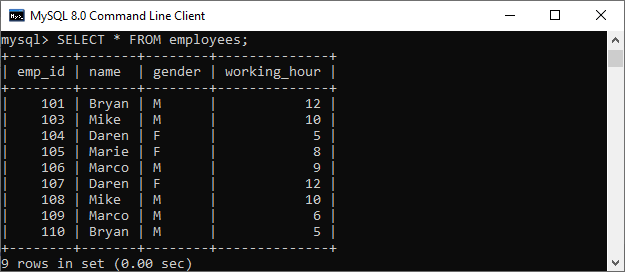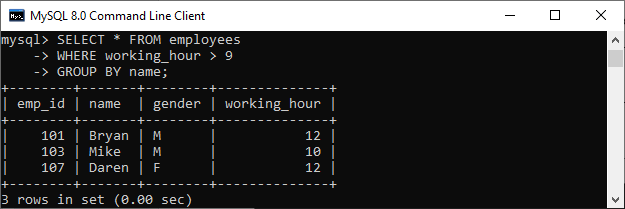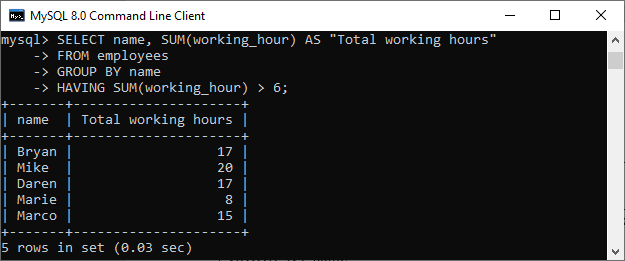The Where Clause Applies to Columns and Expressions for Individual Rows.
incoming → ← prev
Difference between WHERE and HAVING
The WHERE and HAVING clauses are discussed deep in this clause. They're also used to filter records in SQL queries. The difference between the WHERE and HAVING article is the most common question posed during an interview time. The chief difference of opinion betwixt them is that the WHERE article is used to specify a condition for filtering records before any groupings are made, while the HAVING article is wont to stipulate a condition for filtering values from a grouping. Before making the comparison, we will first know these SQL clauses.

WHERE Clause
The WHERE clause in MySQL is used with SELECT, INSERT, UPDATE, and Cancel queries to filter data from the table OR relation. It describes a specific stipulate when retrieving records from a unmarried table or multiple tables using the Joint clause. If the specified condition is satisfied, information technology returns the particular value from the table. The WHERE clause places conditions on the selected columns.
The WHERE clause in MySQL can also implement the logical connectives AND, OR, and NOT. They are known as the Boolean condition that must be avowedly to find the data. The logical connectives expressions use the comparing operators as their operands like <, <=, >, >=, =, and <>. The comparison operators are usually utilized to compare strings and arithmetic expressions.
The following syntax illustrates the use of the WHERE clause:
Let us take an example to sympathize this clause. Suppose we have a table named employees that contain the following data:

If we want to get the employee detail whose working hours are greater than 9, then we can use the argument atomic number 3 follows:
We leave get the on a lower floor output where we can see employee detail whose working hours are greater than 9:

If we employment the above inquiry with the Chemical group BY clause, we will get the different result:
Here is the output:

HAVING Clause
HAVING clause in MySQL used in conjunction with GROUP BY clause enables us to specify conditions that sink in which group results appear in the result. It returns just those values from the groups in the final resultant role that fulfills certain conditions. We can buoy also use the WHERE and HAVING article unneurotic during selection. In this case, WHERE article first filters the someone rows, then rows are grouped, performs aggregate calculations, and finally HAVING clause permeate the groups.
This clause places conditions on groups created by the Grouping BY clause. It behaves the likes of the WHERE article when the SQL affirmation does not use the GROUP BY keyword. We can use the aggregate (group) functions so much every bit Join, MIN, MAX, AVG, and COUNT lone with ii clauses: SELECT and HAVING.
The following syntax illustrates the use of the HAVING article:
Let us take an example to infer this article. Here we are considering the same prorogue employees for demonstration.
If we want to get the total working hours for each employee whose working time is greater than 6 hour, then we can apply the statement equally follows:
We volition get the below output where we can see each employee add together running hours:

Key Differences between WHERE and HAVING Clause
The following points explicate the main differences between database and schema:
- WHERE clause filters individual rows, whereas the HAVING clause filters groups instead of one quarrel at a time.
- We cannot use the WHERE article with conglomeration functions because it works for filtering individual rows. In contrast, HAVING can works with sum functions because it is used to filter groups.
- Quarrel operations are handled by the WHERE article, patc the HAVING clause handles column trading operations to summarized rows or groups.
- WHERE comes before GROUP BY, which way WHERE clause filter rows in front performing aggregate calculations. HAVING comes after GROUP BY, which means the HAVING clause filters rows after performing aggregate calculations. Therefore, HAVING is slower than WHERE in terms of efficiency and should exist avoided wherever doable.
- We toilet combine the WHERE and HAVING clause together in a SELECT query. In this character, the WHERE clause is used prototypal to filter individual rows. The rows are then sorted, do aggregate calculations, and last, the HAVING clause is used to filter the groups.
- The WHERE clause retrieves the desired information based on the specified discipline. On the other hand, the HAVING clause best fetches whole information, and then separation is done based on the nominal condition.
- Without a SELECT argument, we cannot use the HAVING clause. Conversely, we rump use a WHERE with SELECT, UPDATE, and Blue-pencil statements.
- WHERE article is a pre-filter, whereas HAVING article is a post-filter.
WHERE vs. HAVING Comparison Chart
The following comparison chart explains their main differences in a quick style:
| Comparability Basis | WHERE Clause | HAVING Clause |
|---|---|---|
| Definition | It is misused to perform filtration along respective rows. | It is in use to perform filtration on groups. |
| Introductory | It is implemented in row operations. | Information technology is implemented in column operations. |
| Information fetching | The WHERE clause fetches the specific data from particular rows supported the specified train | The HAVING clause first fetches the complete data. It then separates them according to the granted condition. |
| Mass Functions | The WHERE clause does not allow to work with aggregate functions. | The HAVING clause can body of work with aggregative functions. |
| Human action as | The WHERE article Acts as a pre-filter. | The HAVING article Acts American Samoa a post-filter. |
| Used with | We can use the WHERE clause with the Prize, UPDATE, and DELETE statements. | The HAVING clause bottom only use with the Choice financial statement. |
| GROUP BY | The GROUP BY clause comes after the WHERE clause. | The GROUP BY article comes before the HAVING clause. |
Ratiocination
In this clause, we have made a comparison betwixt the WHERE and HAVING clause. Hera, we resolve that both clauses work in the same agency in filtering the data, except around additional feature makes the HAVING clause many touristed. We can efficiently work with aggregate functions in the HAVING clause while WHERE does not allow for aggregate functions.
Next Topic Where condition in SQL
← prev next →
The Where Clause Applies to Columns and Expressions for Individual Rows.
Source: https://www.javatpoint.com/where-vs-having
0 Response to "The Where Clause Applies to Columns and Expressions for Individual Rows."
Post a Comment